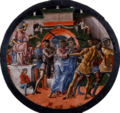|
Pinacoteca Nazionale in Ferrara
The Pinacotecta Nazionale (transl. national picture gallery) is an art gallery in Ferrara, Emilia-Romagna, Italy. It is located on the piano nobile (or first floor) of the Palazzo dei Diamanti, a work of Renaissance architecture by Biagio Rossetti, commissioned by Leonello d’Este in 1447. Not to be confused with the Civic Museum on the lower floor, which has hosted temporary exhibitions of contemporary art since 1992, the Pinacoteca houses a collection of paintings by the Ferrarese School dating from the thirteenth to the eighteenth centuries. It was founded in 1836 by the Municipality of Ferrara after Napoleon's widespread dissolution of churches threatened the protection of important public artworks. The gallery is formed as much around notable northern Italian painters as it is around the exquisite interior decoration of the palace itself, together with remnants of frescoes from local churches and later acquisitions from the Sacrati Strozzi collection. Since 2015 the Pinacoteca Nazionale has formed a part of the Gallerie Estensi, a network of museums sharing Ferrara's cultural heritage with that of Modena and Sassuolo.[1]  Exhibits The Pinacoteca tells the history of the House of Este from that family's promotion as dukes of Ferrara in 1296 to its forced relocation to Modena in 1598. The gallery contains an impressive range of Italian works spanning the reigns of the dukes Leonello, Borso, Ercole I, Alfonso I and Alfonso II d'Este. Arranged chronologically, the exhibition begins with a room dedicated to late Gothic sculpture, fresco and panel painting, progressing through to the early Renaissance, the sixteenth century, Mannerism and lastly to the early seventeenth century, before Cesare I lost Ferrara to the Papal States. Highlights of the tour include the Hall of Honour, the sixteenth-century apartments of Virginia de' Medici (the roundels for these, early products of the Carracci workshop, can be seen in Modena's Galleria Estense) and a room dedicated to the step-by-step process of creating a fresco, panel or oil painting, complementing Cennino Cennini’s Il Libro dell’arte. Gallery
Collection
The Costabili Polyptych by Il Garofalo and Dosso Dossi The Muses Erato and Urania from Leonello d’Este's Studiolo of Belfiore Frescoes from the 14th and early 15th century such as Scenes from the life of St. John the Evangelist and Virtues and Vices. See alsoBibliography
Related entries
References
Other projects
|
||||||||||||||||












